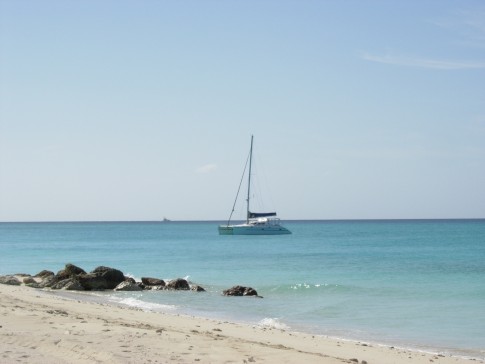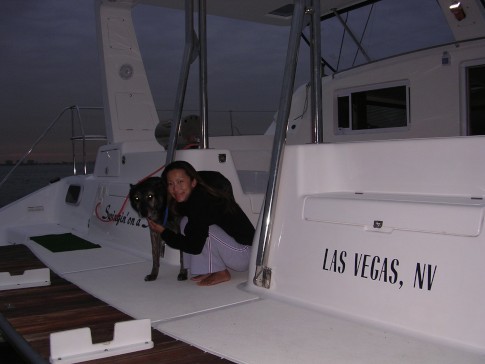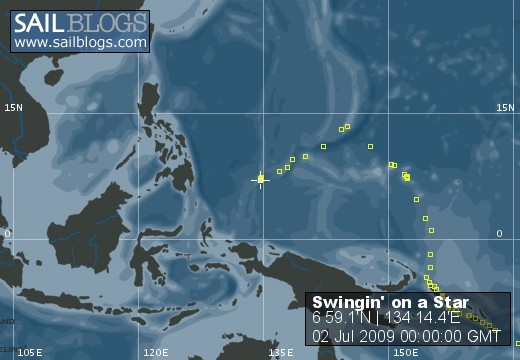
Swingin' on a Star
Ship's log for the circumnavigating Saint Francis 50 catamaran, "Swingin on a Star".
01 April 2010 | Palau
13 July 2009 | Palau
05 July 2009 | Yacht Harbor
03 July 2009 | Peleliu
02 July 2009 | Palau
01 July 2009 | Two Dog Beach
30 June 2009 | Mecharchar
29 June 2009 | Mecharchar
28 June 2009 | Ulong
27 June 2009 | Ngeruktabel
17 June 2009 | Ngeruktabel
16 June 2009 | Ngeruktabel
15 June 2009 | Ngeruktabel
14 June 2009 | Ngeruktabel
13 June 2009 | Ngerutable
25 May 2009 | Yacht Harbor
30 April 2009 | Malakal
29 April 2009 | Koror
28 April 2009 | Malakal
27 April 2009 | Malakal
Fenders
12 January 2007 | Great Exuma
Randy

My most recent gear reflections have been centered on fenders. Fenders are important if you plan to dock your boat or come alongside any hard object (quay, another boat, whatever). Everyone has to come alongside for fuel at least.
The docks in the Caribbean are rarely floating with rubber rails and smartly dressed dock attendants waiting to take your dock lines. More typically they are wood or concrete posts with wood planking in various stages of decay, no cleats and a lonely wind blowing down the planks. Obviously getting onto the leeward side of the dock is always the way to go, but if you are riding out a front with clocking winds or given no choice by the dock master, the windward side of the dock may be in your future.
Fenders are amazing. I have watched our 15 ton boat driven by wind gusting to 30 knots and nasty peaky chop smash the heck out of a set of fenders for three days and they just take it. I will need to reinflate them as soon as we get off of the dock but I am simply amazed that they don't pop, they just deform and reform over and over. Getting a good quality fender is an important investment.
Oversized fenders are always a plus. It is hard for me to imagine a fender being too big (within reason). The only real constraints are price (these buggers are expensive), your ability to store them (you can of course flatten them if need be and then re-inflate them prior to each use) and, if you are using them in a slip, fitting them between the boat and the dock. A good oversized fender can be positioned in a place slightly away from the beamiest part of the boat and still provide total protection. Also as the boat is severely pressed by strong winds and wave chop, larger size will hold the boat off longer and make the motion smoother. In the end, a fender that is too small is useless and a fender that is a little large is great.
Fenders come in various shapes, balls, tubes, pads, etceteras. We have tubes and I think these are the most common. Tubes work well because they roll with a swell or tide and give you a line of coverage rather than a point like a ball. This is particularly important if you need to fend off a dock post in a marina where the boat moves back a forth a bit on her spring lines. The pads strike me as even better in some scenarios because they give you a rectangular area of coverage managing fore and aft as well as up and down variation, perhaps caused by tide. The pads might be a bit tricky to store inflated however.
Strong forces in constant flux tend to squeeze fenders out of their intended position, typically a point of maximum compression. This means constant adjustment and 24 hour supervision or some mechanism for keeping things in place. It has been an ordeal keeping things positioned properly to protect the boat while we wait for a break in the wind to get off of the dock. We ended up mousing down the top horizontal fender in a stacked set of three amidships and keeping lines tight on each end of the fenders to hold them in place. The mouse acts sort of like a breast line with one side looped under the dock boards and the other cleated off on the boat. We have not had to make any adjustments since but a fender board would have been much easier.
Fender boards are a great invention and if you can manage to stow them, wonderful to have. We don't have fender boards but I wish we did. A fender board is a board or some such that you place two or more fenders behind. The dock post rubs the board and the fenders rub the boat. This keeps harsh concrete posts from mauling your fenders and does a much better job of keeping everything in place and providing a large contact surface. Many cruisers make their own fender boards but there are some commercially available products now.
The number of fenders you need depends on the size of your boat. That said I don't think anyone should have fewer than six; three for each side in a slip and three horizontal and two vertical with a spare for alongside tie ups. A few extra may come in handy.
The docks in the Caribbean are rarely floating with rubber rails and smartly dressed dock attendants waiting to take your dock lines. More typically they are wood or concrete posts with wood planking in various stages of decay, no cleats and a lonely wind blowing down the planks. Obviously getting onto the leeward side of the dock is always the way to go, but if you are riding out a front with clocking winds or given no choice by the dock master, the windward side of the dock may be in your future.
Fenders are amazing. I have watched our 15 ton boat driven by wind gusting to 30 knots and nasty peaky chop smash the heck out of a set of fenders for three days and they just take it. I will need to reinflate them as soon as we get off of the dock but I am simply amazed that they don't pop, they just deform and reform over and over. Getting a good quality fender is an important investment.
Oversized fenders are always a plus. It is hard for me to imagine a fender being too big (within reason). The only real constraints are price (these buggers are expensive), your ability to store them (you can of course flatten them if need be and then re-inflate them prior to each use) and, if you are using them in a slip, fitting them between the boat and the dock. A good oversized fender can be positioned in a place slightly away from the beamiest part of the boat and still provide total protection. Also as the boat is severely pressed by strong winds and wave chop, larger size will hold the boat off longer and make the motion smoother. In the end, a fender that is too small is useless and a fender that is a little large is great.
Fenders come in various shapes, balls, tubes, pads, etceteras. We have tubes and I think these are the most common. Tubes work well because they roll with a swell or tide and give you a line of coverage rather than a point like a ball. This is particularly important if you need to fend off a dock post in a marina where the boat moves back a forth a bit on her spring lines. The pads strike me as even better in some scenarios because they give you a rectangular area of coverage managing fore and aft as well as up and down variation, perhaps caused by tide. The pads might be a bit tricky to store inflated however.
Strong forces in constant flux tend to squeeze fenders out of their intended position, typically a point of maximum compression. This means constant adjustment and 24 hour supervision or some mechanism for keeping things in place. It has been an ordeal keeping things positioned properly to protect the boat while we wait for a break in the wind to get off of the dock. We ended up mousing down the top horizontal fender in a stacked set of three amidships and keeping lines tight on each end of the fenders to hold them in place. The mouse acts sort of like a breast line with one side looped under the dock boards and the other cleated off on the boat. We have not had to make any adjustments since but a fender board would have been much easier.
Fender boards are a great invention and if you can manage to stow them, wonderful to have. We don't have fender boards but I wish we did. A fender board is a board or some such that you place two or more fenders behind. The dock post rubs the board and the fenders rub the boat. This keeps harsh concrete posts from mauling your fenders and does a much better job of keeping everything in place and providing a large contact surface. Many cruisers make their own fender boards but there are some commercially available products now.
The number of fenders you need depends on the size of your boat. That said I don't think anyone should have fewer than six; three for each side in a slip and three horizontal and two vertical with a spare for alongside tie ups. A few extra may come in handy.
Comments
| Vessel Name: | Swingin' on a Star |
| Vessel Make/Model: | Saint Francis 50 |
| Hailing Port: | Las Vegas, NV |
| Crew: | Randy Abernethy |
| Home Page: | http://swinginonastar.com |
Swingin on a Star

Who: Randy Abernethy
Port: Las Vegas, NV






